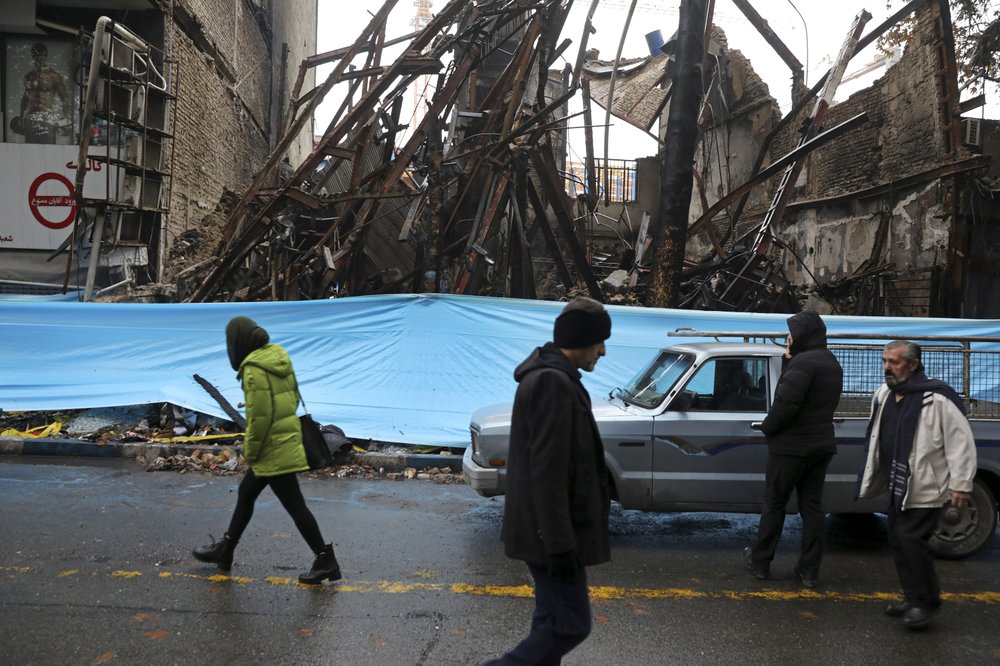
DUBAI, United Arab Emirates (AP) — At least 208 people in Iran have been killed amid protests over sharply rising gasoline prices and a subsequent crackdown by security forces, Amnesty International said on Monday, as one government official acknowledged telling police to shoot demonstrators.
Iran has yet to release any nationwide statistics over the unrest that gripped the Islamic Republic beginning Nov. 15 with minimum prices for government-subsidized gasoline rising by 50%. Iran’s mission to the United Nations disputed Amnesty’s findings early on Tuesday, though it offered no evidence to support its claim.
Iran shut down internet access amid the unrest, blocking those inside the country from sharing their videos and information, as well as limiting the outside world from knowing the scale of the protests and violence. The restoration of the internet in recent days across much of the country has seen other videos surface.
“We’ve seen over 200 people killed in a very swift time, in under a week,” said Mansoureh Mills, an Iran researcher at Amnesty. “It’s something pretty unprecedented event in the history of the human rights violations in the Islamic Republic.”
While not drawing as many Iranians into the streets as those protesting the disputed 2009 presidential election, the gasoline price demonstrations rapidly turned violent faster than any previous rallies. That shows the widespread economic discontent gripping the country since May 2018, when President Donald Trump imposed crushing sanctions after unilaterally withdrawing from Tehran’s nuclear deal with world powers.
Since the summer, tensions across the Mideast have spiked with attacks the U.S. blames on Tehran. Iran, meanwhile, began to break the deal’s centrifuges, enrichment and stockpile limitations with hopes of pressuring Europe to offer it a way to sell crude oil abroad despite Washington’s sanctions.
In a statement Monday, Amnesty said there had been “dozens of deaths” in the Tehran suburb of Shahriar, likely one of the areas with the highest toll of those killed in the unrest. Shahriar had seen heavy protests.
Amnesty offered no breakdown for the deaths elsewhere in the country, though it said “the real figure is likely to be higher.” Mills said there was a “general environment of fear inside of Iran at the moment.”
“The authorities have been threatening families, some have been forced to sign undertakings that they won’t speak to the media,” she said. “Families have been forced to bury their loved ones at night under heavy security presence.”
Authorities also have been visiting hospitals, looking for patients with gunshot wounds or other injuries from the unrest, Mills said. She alleged authorities then immediately detain those with the suspicious wounds.
Iran’s U.N. mission in New York called Amnesty’s findings “unsubstantiated,” without elaborating.
“A number of exile groups (and media networks) have either taken credit for instigating both ordinary people to protest and riots, or have encouraged lawlessness and vandalism, or both,” said Alireza Miryousefi, a spokesman at the mission.
The demonstrations began after authorities raised minimum gasoline prices by 50% to 15,000 rials per liter. That’s 12 cents a liter, or about 50 cents a gallon. After a monthly 60-liter quota, it costs 30,000 rials a liter. That’s nearly 24 cents a liter or 90 cents a gallon. An average gallon of regular gas in the U.S. costs $2.58 by comparison, according to AAA.
Cheap gasoline is practically considered a birthright in Iran, home to the world’s fourth-largest crude oil reserves despite decades of economic woes since its 1979 Islamic Revolution. Gasoline there remains among the cheapest in the world, in part to help keep costs low for its underemployed, who often drive taxis to make ends meet.
Iran’s per capita gross domestic product, often used as a rough sense of a nation’s standard of living, is just over $6,000, compared with over $62,000 in the U.S., according to the World Bank. That disparity, especially given Iran’s oil wealth, fueled the anger felt by demonstrators.
Already, Iranians have seen their savings chewed away by the rial’s collapse from 32,000 to $1 at the time of the 2015 nuclear accord to 126,000 to $1 today. Daily staples also have risen in price.
The scale of the demonstrations also remains unclear. One Iranian lawmaker said he thought that over 7,000 people had been arrested, although Iran’s top prosecutor disputed the figure without offering his own. Meanwhile, a long-detained opposition leader in Iran compared the recent crackdown of protesters to soldiers of the shah gunning down demonstrators in an event that led to the Islamic Revolution, raising the rhetorical stakes of the unrest.
On Twitter, Iranian lawmakers have expressed their anger over the lack of information, although the microblogging website remains otherwise banned in the country.
“In addition to the selective portrayal of destruction of public property, (state-run) Islamic Republic of Iran Broadcasting should show a few protesters being shot,” lawmaker Mahmoud Sadeghi of Tehran wrote sarcastically.
Meanwhile, the governor of a Tehran suburb that saw demonstrations openly acknowledged in a video interview with the state-owned IRAN newspaper that she ordered police to shoot protesters if they stormed her offices. Shahr-e Quds Gov. Leila Vaseghi also said she sent text messages to citizens telling them not to join the “rioters” and that there was a “possibility of a shooting” if they did.
“I had told (the police): ‘Shoot at anybody who crosses the gate of the governor office,’” Vaseghi said in the interview.
Reporting by Jon Gambrell
Image: In this Nov. 20, 2019 file photo, people walk past buildings that were burned during recent protests, in Shahriar, Iran, some 40 kilometers (25 miles) southwest of the capital, Tehran (AP Photo/Vahid Salemi, File)




